
© Reuters. FILE PHOTO: Two buyers look at models of apartments on sale at The Parkside, in Macquarie Park, Sydney, Australia, February 25, 2023. REUTERS/Stella Qiu
2/2
By Stella Qiu
SYDNEY (Reuters) – A year-long slide in Australian home prices is showing signs of bottoming out far earlier than anyone thought possible, greatly lessening the risk of a jump in distressed sales and raising hopes for a soft landing in the economy.
Defying predictions of a crash, prices in Australia’s eight capital cities have actually risen 0.8% so far in March from February, data from property consultancy CoreLogic showed. The peak to trough decline in these cities of about 10% has only partially unwound the almost 26% surge during the COVID period.
This will be the first monthly gain since values peaked in April last year before the Reserve Bank of Australia embarked on its most aggressive tightening campaign in modern history.
The rebound has been most pronounced in hard-hit Sydney where prices are up 1.4% month-on-month so far in March. That leaves them down 13% from their peak, relatively modest compared to the eye-popping surge of almost 30% during the COVID pandemic.
The tentative turnaround has been a surprise to economists who had expected the slide to last all year given mortgage rates have just hit decade highs after 10 straight rate hikes.
Yet now there is a real chance the Reserve Bank of Australia (RBA) will pause its tightening campaign next week with rates at 3.6%, well below those in the United States or UK.
Eliza Owen, head of Australian research at CoreLogic, says if this is the peak for rates, a recovery in the housing market could happen sooner than projected.
“We might have seen the market bottoming out now,” she said. “I think, for us, we’re just being a bit cautious right now because of the risks that lie ahead this year.”
Persistently low levels of housing stock and surging immigration levels are also helping provide a floor to prices, with auction clearance rates across capital cities rebounding to the highest in a year just last weekend.
Economists are still warning the full impact of rate hikes have yet to be fully felt given a large chunk of loans fixed at ultra low rates during the pandemic are set to be refinanced at punishingly high rates later this year.
Yet the RBA estimates that only 0.5% of all home loans are in negative equity, a situation where the home loan exceeds the value of the property and could lead to increased defaults. If prices fell another 10%, that would still only rise to 1%.
Mortgage arrears are also near record lows and the portion of loss-making sales are trending below the decade-long average.
A crash in housing prices would threaten the RBA’s central scenario that the economy is headed for a soft landing this year, with growth projected to slow to 1.5% from 2.7% last year.
‘EASIER TO BUY THAN TO RENT’
A resurgence in migration has added to underlying demand at a time when approvals to build new homes have plunged to the lowest since mid-2012.
The Treasury now expects net overseas migration to be in the mid-300,000s or more for the year to June, compared to 235,000 projected in October. New migrants tend to rent rather than buy, setting fire to that market.
Chris Bedingfield, a portfolio manager at Quay Global Investors in Sydney, says the blisteringly hot rental market is a major reason home owners are holding onto their properties rather than sell.
Annual growth in rents hit 4.8% in February, an almost five-fold increase from a year earlier.
“You can say interest rates are a headwind, but rents and supply restriction is a huge tailwind…I don’t know who’s gonna win that battle in the short term. But I do know in the long term who wins – demand is going to overwhelm supply.”
Rising rental yields, especially with the return of Chinese students, have lured some investors back to the apartment market, said Chet Qiang, a developer’s representative at The Parkside near Macquarie University in Sydney.
“We have buyers buying five or six apartments at once,” said Qiang, who just launched their latest opening of off-the-plan apartments in late February. “I’d say what is peculiar this time is that we have about 50-60% of buyers who are investors, compared with just 15-20% before.”
Peter Li, a real estate agent in Sydney, has noticed Chinese students were making inquiries about buying recently, a group of customers who he would least expect to be serious buyers.
“It turns out they’re quite rich. A lot of those kids couldn’t manage to find a rental even with money in their hands, so the awkward reality right now is it is easier to buy than to rent.”





